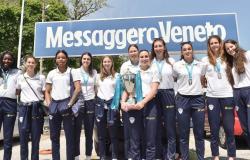The exhibition will close in the next few hours, well in advance of the scheduled deadline of June 2nd Gratia Plena, set up since March 2nd in the diocesan museum of Carpi (Modena) and ended up at the center of news and controversy. Was the artist from Carpi Andrea Saltini, author of the exhibition, attacked and injured at the end of March by an unknown person who stabbed him in the neckafter accusations of blasphemy made by some traditionalist sites and movements, announced the stop of the exhibition via Facebook.
The painter himself explained: «The decision is dictated by my precarious state of health, following the attack and the continuous demonstrations of dissent which culminated in the well-known episodes of physical and verbal violence. Furthermore, it is no longer possible for me to bear the costs relating to security, previously unforeseen, which are essential in order to guarantee the peaceful access of visitors to the exhibition and the safety of all collaborators and volunteers. A heartfelt and dutiful thank you – he concluded – to the curators of the exhibition, to my team and to all those who supported me”.
The comment was immediate diocese of Carpi – united from 2020 episcopi in person to that of Modena-Nonantola -, which he defined «the succession of hate attacks also against the Church of Carpi and its pastors is serious». In a note, the diocesan museum “Cardinal Rodolfo Pio of Savoy”, expressing «full understanding and sharing of the reasons given», thanked Saltini who «shared an attempt, partly pioneering, to identify possible interactions between artistic experiences contemporary and religious paths and mystical research. The gravity of the succession of hate attacks is not lost on us”, nor “the violence against a work and even against the artist himself”, in addition to the “systematic and aggressive demonstrations of hostility towards the Church of Carpi and, specifically , of its shepherds. He regrets that the repeated invitations to seek a peaceful, frank and correct dialogue, lowering the noisy and coarse tones, were not accepted.” The diocese of Carpi also announced that “over two thousand people visited the exhibition and civilly expressed their impressions”.
Andrea Saltini, “Inri – San Longino”, 2024 – CsArt/Diocesan Museum of Carpi
The news of the closure was instead welcomed by the association “Pro Vita & Famiglia Onlus”, whose president, Antonio Brandi, stated that there has been an “end to the exhibition, in a consecrated church, of works that depict Christ and the Madonna in sexually ambiguous contexts, so much so that they can be considered openly blasphemous. The initiative – declared the association – has for months aroused confusion and dismay among faithful and citizens, who found their voice in the popular petition of Pro Vita & Famiglia signed by more than 30,000 signatories”. For Brandi “attempts to find forms of dialogue with contemporary art and culture” must never “compromise the sense of the sacred and the popular sentiment of faithful and citizens”.
The accusations, the diocese’s response, the complaint filed
A few weeks after the opening, criticism and accusations of blasphemy arose against Saltini’s works. Not only: in mid-March it was presented a complaint to the Modena prosecutor’s office “paid” by the archbishop of Modena-Nonantola and bishop of Carpi, Erio Castellucci, by the artist himself and by the curators of the exhibition, Don Carlo Bellini and Cristina Muccioli, «for contempt of the Catholic religion, blasphemy and exhibition of blasphemous images in a sacred place with an attached request for seizure of the obscene paintings where Jesus and Mary are represented in sexual acts». However, the Prosecutor’s Office requested that the case be dismissed of the file: according to the public prosecutor Giuseppe Amara, these are «works attributable to the activity of an artist, the result of his own elaboration which, whether agreeable or not, is a free manifestation of thought, moreover, susceptible to different interpretations by the user of the works and not an expression of gratuitous contempt towards religious confession”. The Prosecutor’s Office specified that it is “also possible that the meaning attributed is different from the offensive one, as perceived by the exponents”.
The response of the local Church, in the aftermath of the legal initiative, was timely in rejecting the accusations, considering the comments «disrespectful and undetectable in the face of a correct vision of the works. As for the judgements, or prejudices – the diocese has always highlighted – according to which some paintings exhibited reproduce blasphemous or irreverent images, despite falling within the free circulation of opinions”, they “are disrespectful towards the path taken by the artist and also by the promoters ». In short, “none of this is detectable when looking at the works correctly, documented and with a clear eye”.
The meaning of the works on display
About twenty large works, mostly created for the occasion, which were hosted in the diocesan museum, in the former church of Sant’Ignazio. The subjects are of religious inspiration, even if the artist is not a believer: it is therefore not “sacred art”. In the preface to the catalog Don Carlo Bellini, episcopal vicar for Pastoral Care, wrote that «spirituality can be linked to a religion but also be a spirituality without God, as a natural expression of human maturity. I like the sociologist Luigi Berzano’s summary that spirituality is a system of meaning that makes his own biography plausible for an individual. If we observe Andrea Saltini’s works we must recognize that they are imbued with spirituality.”
One of the moved works – Fotogramma
Tags: attack accusations blasphemy exhibition closes






